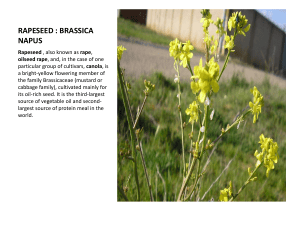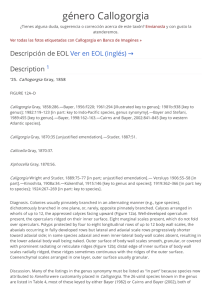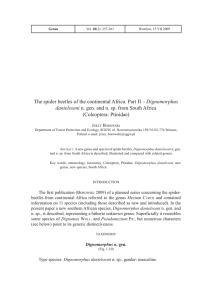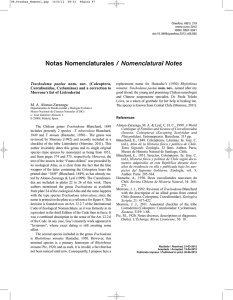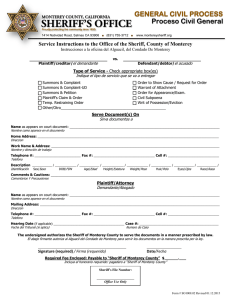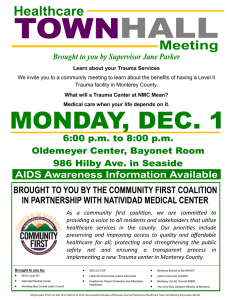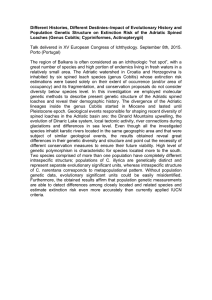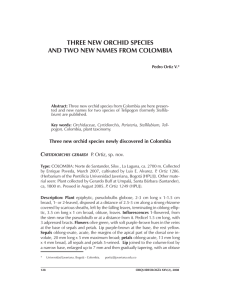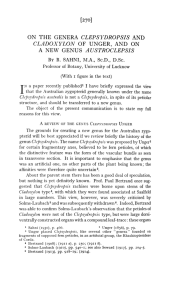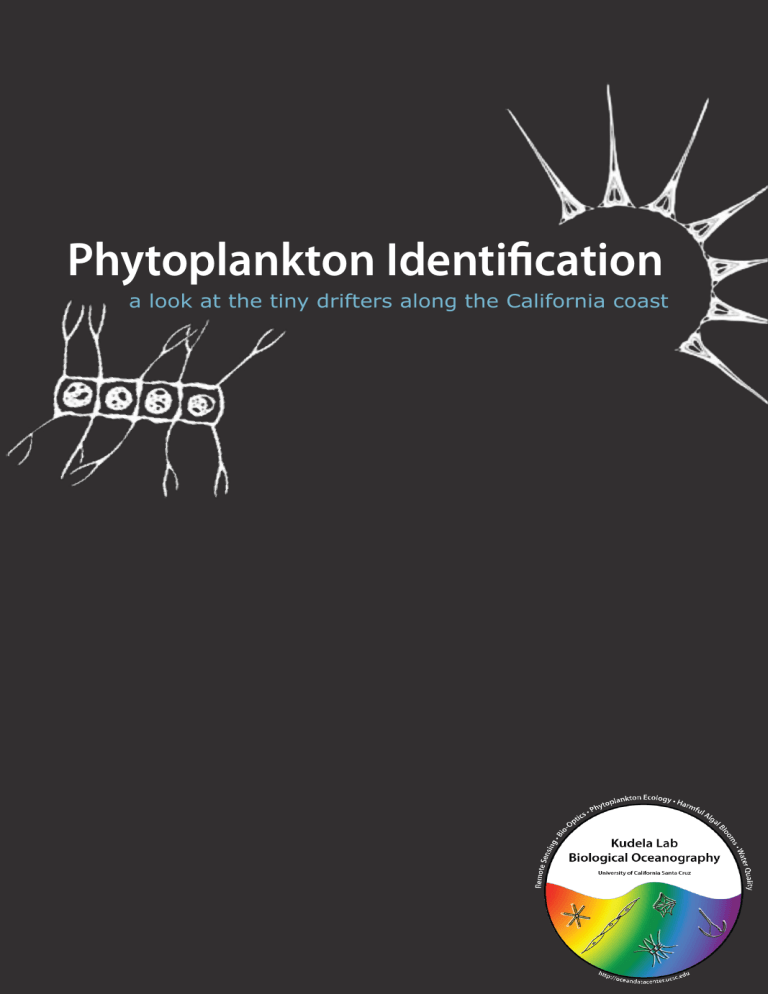
Phytoplankton Identification a look at the tiny drifters along the California coast Table of Contents Introduction.................................................................................... 3 Microphotography............................................................................ 5 Pigment Analysis............................................................................. 6 HABs and red tides.......................................................................... 7 Marine Diatoms............................................................................... 8 Marine Dinoflagellates...................................................................... 40 Freshwater...................................................................................... 63 Glossary......................................................................................... 88 Phytoplankton index........................................................................ 90 2 Consider this... 3 for every breath of air you take, half the oxygen is courtesy of plants from the land, and the other half from the phytoplankton - the plant-like organisms of the ocean. Phytoplankton produce oxygen and contribute close to half of the total global oxygen supply. On the other side of the equation, phytoplankton absorb one third of the carbon dioxide (CO2) produced globally, whether from our exhaled breath or by the combustion of fossil fuels. Phytoplankton play a pivotal role in the removal of CO2 from the atmosphere to the oceans and thus are key mediators of the global climate. These tiny one-celled organisms, often less than half the diameter of a human hair, make up what might be considered the grasslands of the ocean. They form the base of the pelagic marine food web and are grazed on by krill, the primary food source of many animals in Monterey Bay, from sardines to whales. Viewed under a mircoscope, a mere drop of water teems with an astonishing diversity of phytoplankton. These microscopic organisms, largely invisible to the naked eye, are crucial to the survival of life on earth. 4 Microphotography 1 2 3 4 1: Brightfield Microscopy: Simplest microscopy illumination technique. Specimen is illuminated from below and observed from above. Specimens typically appear as dark shapes against a bright background. 2: Darkfield Microscopy: Illumination technique used to enhance the contrast in specimens. Specimen is illuminated with light that will not be collected by the objective lens, and therefore will not form part of the image. This produces the appearance of a bright object against a dark or black background. 3: Phase Contrast Microscopy: An illumination scheme that converts phase shifts of light passing through a transparent specimen into contrast changes, thus rendering cell features more visible. 4: Epifluorescence Microscopy: A beam of light causes a cell to fluoresce, and the emitted light is then focused by the objective lens. Stains are commonly used for highlighting specific proteins or molecules of interest; here 5 the chloroplasts are stained. Pigment analysis Phytoplankton cells are commonly identified with a microscope. A trained technician can identify many different kinds of diatoms and dinoflagelates in a plankton sample. However, the emerging science of pigment analysis can be faster, cheaper, and less labor-intensive. An advantage to pigment analysis is identification of very small or rare cells that are difficult to detect through microscopy. Different classes of phytoplankton produce different pigments. In addition to chlorophyll-a, diatoms produce brown fucoxanthin, dinoflagellates have brown-gold peridinin, and cyanobacteria make orange zeaxanthin. By analyzing samples with high-performance liquid chromatography, or HPLC, each type of pigment present is isolated and identified. This chart shows the relative percentage of each type of phytoplankton in a water sample, as identified through traditional microscopy. This chart shows the results of analyzing the same sample with HPLC technology. 6 HABs and Red Tides When conditions are favorable, phytoplankton can grow and multipy rapidly, or “bloom.” Due to pigments in the cells, some dense blooms can turn the water red, brown or orange. These blooms are called Red Tides. Certain phytoplankton species are capable of producing toxins. A bloom of a toxic species, which can be dangerous to animal and human health, is called a Harmful Algal Bloom (HAB). Red Tides can be harmless, and HABs can be colorless. Toxigenic species in this book are identified by this logo: For more information, visit: www.HABMAP.info http://oceandatacenter.ucsc.edu/PhytoGallery/HABS_redtides/html 7 Marine Diatoms • Single-celled algae that possess a distinct nucleus (eukaryotic) • Divided into two major groups based on the structure and shape of the valves: Centrics (Order: Biddulphiales) and Pennates (Order: Bacillariales) • They are plant-like and meet their nutritional needs through photosynthesis The presence of chlorophyll and accessory pigments, especially fucoxanthin, give them a golden color and serves to harvest light energy from the sun • Cells are encased in a transparent glass-like silica frustule that resembles a petri-dish • Frustules can be ornate and very beautiful, and due to the strength of silica, they form an important part of the fossil record • Cells may form chains or colonies • Up to 100,000 species of diatoms have been recorded world-wide Pennate Centric Valves Frustule (cell wall) Chloroplasts 8 Frustule (cell wall) Genus: Asterionellopsis Diatom Monterey Bay Species: A. glacialis, A. kariana Order: Bacillariales (Pennate) Family: Fragilariaceae Description: Pennate diatom. Cells joined by valve faces into star-shaped or spiraling chains. Two chloroplasts present. Cell Size: Length (apical axis) = 30 – 150um Distribution: Neritic, cosmopolitan in cold to temperate coastal waters. Often occurs as a member in the diatom surf zone community and sometimes can form fairly dense blooms. 9 Genus: Asteromphalus Diatom Order: Asterolamprales Family: Choreutoidea Description: Centric diatom, valve outline broadly oval or circular, or oblong. One hyaline ray narrower than the others (for A. hookeri). Narrow ray is either rectangular or bell shaped, and sectors are wedge shaped and curve towards valve center. Cell Size: Diameter = 42 – 175um Distribution: Warm , temperate and southern cold water regions. 10 attheya Genus: Attheya Diatom Order: Chaetocerotales Family: Attheyaceae Description: Centric diatoms. Cells can be solitary or form short chains. Attheya is similar in appearance to Chaetoceros, but can be identified by valve outgrowths or horns and by type of girdle bands. Attheya can be both planktonic or epiphytic and is often found attached to sand grains or other diatoms. Cell Size: Width (apical axis) = 4-10um Distribution: Northern cold water to temperate, also found in freshwater. 11 Genus: Bacteriastrum Diatom Monterey Bay Species: B. cosmosum, B. hyalinum Order: Biddulphiales Family: Chaetocerotaceae Description: Cylindrical cells bound together by the fusion of numerous setae that are regularly arranged around the cell margin. Cells have numerous small round chloroplasts. Setae are of varying shapes (branched, divided, & curved). Cell Size: Diameter (apical axis) = 5 – 56um Distribution: Temperate, coastal waters. 12 cerataulina Genus: Cerataulina Diatom Monterey Bay species: C. pelagica, C. bicornis, C. dentata Order: Hemiaulales Family: Hemiaulaceae Description: Cells form close-set chains by apposition of tips of elevations. Cells have bipolar symmetry and bipolar elevations, and numerous small disk-like chloroplasts. The apertures between cells in chains are narrow, and cells are twisted about the pervalvar axis. Cell Size: Pervalvar axis = 55-200um, diameter = 5-75um Distribution: Cosmopolitan, warm coastal areas. 13 Genus: Chaetoceros Diatom Monterey Bay species: C. didymus, C. decipiens, C. debilis, C. convolutus, C. constrictus, C. compressus, C. radicans Order: Biddulphiales Family: Chaetocerotaceae Description: Cells form chains that are coiled, curved or straight. Long setae emerge from corners of cells. One of the largest genera of diatoms, roughly 400 species, most of which are marine. Some species form resting spores and/or auxospores. Cell Size: Width (apical axis) varies with species, roughly ranges from <10um to 50um. Distribution: Widespread throughout the world’s oceans, often dominant in Monterey Bay. 14 Genus: Corethron Diatom Monterey Bay species: C. hystrix Order: Biddulphiales Family: Corethraceae Description: Cylindrical cells with more or less dome-shaped valves. Generally solitary. Girdle is composed of many bands. Spines on both valves, one valve with series of short hooked spines, in addition to the longer ones. Chloroplasts are flat, elongated, and near the center of the cell. Cell Size: Diameter (apical axis) = 20 – 40um, Length (pervalvar axis) = 20 – 150um Distribution: Oceanic in the North Atlantic and North Pacific, sometimes found in inshore waters. 15 Genus: Coscinodiscus Diatom Monterey Bay Species: C. centralis, C. granii Order: Biddulphiales Family: Coscinodiscaceae Description: Cells disc-shaped, cylindrical or wedge-shaped, and solitary. Distinct rosette of large areolae in the center of the valve. Cell Size: Diameter (apical axis) = 30 – 500um Distribution: Widespread-warm water to boreal. Interesting Facts: One of the largest marine planktonic diatom generas (400–500 taxa described and identified). 16 Genus: Cylindrotheca Diatom Monterey Bay Species: C. closterium, C. fusiformis Order: Bacillariophycidae Family: Bacillariaceae Description: Valve faces weakly silicified. Raphe transversed by a series of fibulae which are joined directly to the valve face. Two prominent chloroplasts. Cell Size: length (apical axis) 30-400um, transapical axis 2.5-8um Distribution: Cosmopolitan. Planktonic, commonly found on seaweeds and polar ice. 17 Genus: Detonula Diatom Monterey Bay Species: D. pumila *similar appearance to Lauderia Order: Biddulphiales Family: Thalassiosiraceae Description: Cylindrical cells joined together in straight, stiff chains by short processes and mucilage threads. Cell Size: Diameter (apical axis) = 16 – 42um Distribution: Neritic, cosmopolitan, may prefer warmer waters Synonym: Schroederella delicatula. 18 Genus: Ditylum Diatom Monterey Bay Species: D. brightwellii Order: Biddulphiales Family: Lithodesmiaceae Description: Cells solitary, in short chains or, rarely, long chains. Cells have small, numerous chloroplasts and a long central spine. Produce resting spores. Cell Size: Length (pervalvar axis) = 80 – 130um Distribution: Cosmopolitan excluding polar waters. 19 Genus: Entomoneis Diatom Order: Rhopalodiales Family: Entomoneidaceae Description: Genus found in marine, brackish, and freshwater environments. Girdle view shows two highly arched bilobate keels, one on each valve. The keels are slightly torsioned so that the lobes are not all in focus at one time. Several girdle bands are present and form a crossing, sigmoid pattern. Cell Size: length 35-85um, width 20-30um 20 Genus: Eucampia Diatom Monterey Bay Species: E. zoodiacus Order: Biddulphiales Family: Hemiaulaceae Description: Forms elliptical chains. Cells are connected by two processes. Many discoid chloroplasts. Cell Size: Length (apical axis) = 10 – 92um Distribution: Cosmopolitan, probably absent from polar regions. Interesting Facts: First identified in 1831. 21 Genus: Guinardia Diatom Monterey Bay Species: G. striata, G. delicatula Order: Biddulphiales Family: Rhizosoleniaceae Description: Cylindrical cells that form curving and sometimes spiraling chains. Girdle bands appear as collars. Small numerous chloroplasts. Cell Size: Width = 6 – 45um, Length = 250um Distribution: Neritic, widespread, probably cosmopolitan. Synonym: Rhizosolenia stolterfothii 22 hemiaulus Genus: Hemiaulus Diatom Order: Hemiaulales Family: Hemiaulaceae Description: Cells form chains, sometimes curved or twisted. Valves are elliptical with long and sometimes claw-like elevations (connecting horns). Cell Size: Width (apical axis) = 15-35um Distribution: Oceanic to neritic, temperate to warm water 23 Genus: Lauderia Diatom *similar appearance to Detonula Order: Biddulphiales Family: Thalassiosiraceae Description: Centric diatom. Cells form chains, and are separated by occluded processes on marginal part of valve. The valve surface has faint radial ribs. Cell Size: Diameter = 24-75um, Width (pervalvar axis) = 26-96um Distribution: warm water to temperate 24 Genus: Leptocylindrus Diatom Monterey Bay Species: L. danicus, L. mediterraneus, L. minimus Order: Biddulphiales Family: Leptocylindraceae Description: Tight chains with abutting valve surfaces. Forms resting spores. Cell Size: Diameter (apical axis) = 5 – 16um Distribution: Cosmopolitan. Interesting Fact: L. mediterraneus is nearly always found with epiphytic flagellate Solenicola setigera. 25 licmophora Genus: Licmophora Diatom Order: Licmophorales Family: Licmophoraceae Description: Epiphytic diatom, cells grow on a common stalk that is attached to rocks or algae. Often found in low numbers in shallow or turbid environments, both marine and freshwater. Distinct triangular or fan-shaped cells. Cell Size: Distribution: 26 lioloma Genus: Lioloma Diatom Monterey Bay species: Lioloma pacificum Order: Bacillariales Family: Thalassionemataceae Description: Delicate cells are united in fan-like colonies. Cell Size: Width (pervalvar axis) = 1.8-7um, Length (apical axis) = 525-1,920um Distribution: Warm to temperate waters 27 Genus: Lithodesmium Diatom Order: Lithodesmiales Family: Lithodesmiaceae Description: Centric diatom. Cells can be solitary or form ribbonlike chains. Cells are rectangular or square in girdle view, and triangular or quadrangular in valve view. Cells have elevations at valve corner, and numerous small chloroplasts are visible. Cell Size: Width (pervalvar axis) = 20-75 um Distribution: Range from warm to temperate waters. Some species are benthic. Distribution: Warm to temperate waters. 28 Genus: Odontella Diatom Monterey Bay Species: O. longicruris, O. aurita Order: Biddulphiales Family: Eupodiscaceae Description: Heavily silicified cells form curving or spiraling chains joined by mucous pads on ends of elevations. Numerous small chloroplasts. Cell Size: Width (apical axis) = 10 – 97um Distribution: Most abundant in north temperate regions, and likely cosmopolitan. May be a littoral species. 29 Genus: Pleurosigma Diatom Order: Bacillariales Family: Bacillariineae Description: Solitary pennate diatom with a gentle sigmoid shape. Has 2-4 elongated chloroplasts. Cell Size: Width = 28 – 75um, Length = 90 – 600um Distribution: Cosmopolitan. 30 Genus: Proboscia Diatom Monterey Bay Species: P. alata Order: Biddulphiales Family: Rhizosoleniaceae Description: Long, cylindrical cells. Valves terminate in a proboscis. Auxospores sometimes present. Cell Size: Diameter (apical axis) = 7 – 18um, Length (pervalvar)= 1mm Distribution: Oceanic temperate waters, sometimes coastal. Synonym: Rhizosolenia alata. 31 Genus: Pseudo-nitzschia Diatom Monterey Bay species: P. australis, P. multiseries, P. pungens, P. fraudulenta, P. pseudodelicatissima Order: Bacillariales Family: Bacillariaceae Description: Cells are elongate, fusiform or rectangular in girdle view. Form chains by overlapping of cell ends. Chains of 20 or more cells are not uncommon. Cell Size: Width = 2 – 8um, Length = 40 – 175um Distribution: Widespread Interesting Facts: Many species produce domoic acid, the neurotoxin responsible for Amnesiac Shellfish Poisoning. Fish feed on these cells and transfer the domoic acid to their predators, which include seabirds and marine mammals. The toxin has a deleterious effect on these animals, often resulting in their deaths. The species capable of producing domoic acid do not do so all the time. The conditions that trigger toxin production are of great interest to researchers. 32 Genus: Rhizosolenia Diatom Monterey Bay species: R. setigera, R. hebatata, R. styliformis, R. robusta Order: Biddulphiales Family: Rhizosoleniaceae Description: Long, cylindrical, straight or slightly curved cells with a spine-like process on one end. Cells may be solitary or in short chains. Valves are conical or subconical. Segmented girdle bands are in longitudinal columns roughly parallel to the pervlavar axis. Cells have numerous small chloroplasts. Cell Size: Diameter = 13 – 230um among five most common species. Distribution: Widespread throughout the world’s oceans. 33 Genus: Skeletonema Diatom Monterey Bay species: S. costatum Order: Biddulphiales Family: Thalassiosiraceae Description: Cells in chains, attached by external tubes or strutted processes organized in one marginal ring. Two chloroplasts per cell. Cell Size: Diameter = 2 – 21um Distribution: Cosmopolitan in coastal waters excluding polar regions. 34 Genus: Stephanopyxis Diatom Order: Biddulphiales Family: Melosiraceae Description: Cylindrical, sometimes nearly spherical, capsule-shaped cells. Valves are domed with large hexagonal areolae. Cells have numerous discoid or lobed chloroplasts. Some species form resting spores. Cell Size: Diameter (apical axis) = 24 – 71um Distribution: Some species are found in temperate to northern cold water, other species are found in temperate to warm waters. 35 Genus: Thalassionema Diatom Order: Bacillariales Family: Thalassionemataceae Description: Cells attached together by mucilage pads at their ends into stellate and/or zigzag-like colonies. Cell Size: Length (apical axis) = 10 – 80um, Width (pervalvar) = 2 – 4um Distribution: Neritic, cosmopolitan in temperate to tropical waters. 36 Genus: Thalassiosira Diatom Monterey Bay Species: T. rotula, T. aestivalis, T. nordenskioldii, T. anguste-lineata, T. weisflogii Order: Biddulphiales Family: Thalassiosiraceae Description: Well-studied marine genus with over 100 species. Discoid cells are in chains or are embedded in mucilage (i.e. T. subtilis). Chains-forming species are connected by a central organic thread. Numerous spine-like threads also extruded from strutted processes on valve margins. Cell Size: Diameter (apical axis) = 3 – 186um Distribution: Widespread throughout the world’s oceans 37 Genus: Thalassiothrix Diatom Monterey Bay Species: T. longissima, T. antarctica, T. gibberula Order: Bascillariales Family: Thalassionemataceae Description: Very long cells that can be solitary or form radiating colonies. Cells can be straight, slightly curved, or sigmoid, and are usually strongly twisted. Valves inflated at the center and apices, and marginal spines are present. Can be mistaken for Thalassionema. Cell Size: Apical axis = 530-4000um, transapical axis 2.5-6um Distribution: Widespread throughout the world’s oceans 38 Genus: Tropidoneis Diatom Monterey Bay Species: T. antarctica Order: Naviculales Family: Naviculaceae Description: Solitary cells. Elliptical or slightly constricted in the center in valve view. Chloroplasts rod-like and numerous, radiating from central nucleus. Cell Size: 160-350 um Distribution: Common in Puget Sound in the summer, occasionally found in California waters. 39 Marine Dinoflagellates • Single-celled algae that possess a distinct nucleus (eukaryotic) • Posess two flagellae for mobility • Cells are covered by a cellulose theca (sheath) that can be smooth or ornamented • Some species migrate vertically in the water, possibly seeking nutrients, prey or refuge from damaging UV rays • Many species form chains of linked cells • Nearly half of known species are capable of photosynthesis (autotrophy) and possess light-harvesting pigments • Some can absorb organic matter &/or engulf microbial prey (heterotrophy) • Some species are capable of a combination of autotrophy and heterotrophy • Of the 2000 species identified, about 60 are known to produce complex toxins • When conditions are favorable, a population explosion or bloom may occur, sometimes resulting in contamination of fish and shellfish and posing a threat to human and animal health. Unarmoured Armoured Photosynthetic pigments Flagellum Cingulum Cellulose plates 40 Genus: Akashiwo Dinoflagellate Monterey Bay Species: A. sanguinea Order: Prorocentrales Family: Gymnodiniales Description: Unarmored cells. Dorsoventrally flattened. Epitheca is broadly conical and the hypotheca is bilobed. Large, central nucleus and numerous chloroplasts. Cells can be deeply pigmented or clear, can form extensive blooms that color the water red. Cell Size: Length = 40 – 80um Distribution: Cosmopolitan in temperate to tropical coastal and estuarine waters. Synonyms: G. sanguineum and G.splendens. 41 Genus: Alexandrium Dinoflagellate Monterey Bay Species: A. catenella Order: Gonyaulacales Family: Goniodomataceae Description: Armoured cells, typically spherical. Cell Size: Less than 45um Distribution: Coastal temperate to tropical waters. Interesting Facts: Several species, including Alexandrium catenella, are toxic and/or bioluminescent. They produce saxotoxins, among others, which lead to paralytic shellfish poisoning. 42 amphidinium Genus: Amphidinium Dinoflagellate Order: Gymnodiniales Family: Gymnodiniaceae Description: Unarmoured (athecate) free-living cell, sometimes enclosed in a hyaline cyst. Some species are bethic or epiphytic. Cells can be globular or fusiform, and contain one large, lobed chloroplast. Large, dense blooms of Amphidinium can result in red tides. Some species can produce toxins. Cell size: 12-18um length, 8-10um wide 43 amylax Genus: Amylax Dinoflagellate Monterey Bay Species: A. triacantha Order: Gonyaulacales Family: Gonyaulacaceae Description: Cells are small and delicate with atapered apical horn or spike and one or more antapical spines. Chloroplasts present. Cell Size: Length = 42-60um Distribution: Coastal cold water species in both Pacific and Atlantic. Synonym: Amylax tricantha = Gonyaulax triacantha 44 Genus: Boreadinium Dinoflagellate Monterey Bay Species: B. pisiforme Order: Peridiniales Family: Diplosaliacea Description: Slightly compressed thecate cells, with prominent left sulcal list. Scattered pores on cell surface. Chloroplasts absent. Cell Size: Less than 45um Distribution: Coastal, cold temperate 45 Genus: Ceratium Dinoflagellate Monterey Bay species: C. furca, C. lineatum, C. pentagonum, C.cf fusus, C. platycorne Order: Gonyaulacales Family: Ceratiaceae Description: Large, diverse genus. Armoured, gonyaulacoid body, two to four hollow horns. Horns open or closed. Chloroplasts present Cell Size: Width = 5 – 50um, Length = ~70 – 500um Distribution: Cosmopolitan, neritic, cold and warm waters. C. furca is very common in Monterey Bay and often forms dense blooms. 46 Genus: Cochlodinium Dinoflagellate Monterey Bay species: C. fulvescens Order: Gymnodiniales Family: Gymnodiniaceae Description: Unarmored cells with cingulum rotating more than 1.5x. Single cells or chain-forming, with or without chloroplasts. Encystment common. Cell Size: Width = 20 – 40um, Length = 60 – 80um Distribution: Cosmopolitan in warm and temperate waters. Interesting Facts: A toxin producer. Recently, and for the first time, dense blooms of Cochlodinium have been reported in Monterey Bay. 47 Genus: Dinophysis Dinoflagellate Monterey Bay species: D. acuminata, D. fortii, D. tripos, D. rotundata, D. caudata Order: Dinophysiales Family: Dinophysiaceae Description: Armored, laterally flattened, oval-shaped cells with small flat or rounded epitheca. Hypotheca is usually about ¾ of the cell length. Wide girdle bounded by lists. Chloroplasts present or absent. Cell Size: Width = 30 – 60um, Length = 22 – 105um Distribution: Widespread throughout the world’s oceans. Interesting Facts: Produce toxins. 48 Genus: Gonyaulax Dinoflagellate Monterey Bay species: G. spinifera, G. polyedrum Order: Gonyaulacales Family: Gonyaulacaceae Description: Armored, ovoid to fusiform cells with chloroplasts. Some species form benthic cysts. Distinguished by descending cingulum up to 6x girdle width. Cell Size: Width = 25 – 136um Distribution: Widespread throughout the world’s oceans. Interesting Fact: Gonyaulax spinifera can produce yessotoxin. 49 Genus: Gymnodinium Dinoflagellate Monterey Bay species: G. breve, G. catenatum *Similar appearance to non-toxic Gyrodinium (next page) Order: Dinotrichales Family: Dinotrichaceae Description: Small- to medium-sized cells often pentagonal with a conical epitheca, bilobed hypotheca, and large nucelus. Chloroplasts present. Can be circular or compressed in cross-section. G. catenatum produces characteristic cysts. Cell Size: Length = 40-75um Distribution: Oceanic to estuarine; warm temperate to tropical Interesting Facts: Some species produce saxitoxins. 50 Genus: Gyrodinium Dinoflagellate *Similar appearance to toxin-producing Gymnodinium (previous page) Order: Gymnodiniales Family: Gymnodiniaceae Description: Small- to large-sized cells. Can be fusiform, biconical, ovoid, or tear-shaped, somtimes compressed dorsoventrally or laterally. Some species have apical groove. Pigmentation and nutrition vary - some species have food vacuoles. Cell Size: Varies from <5um to >200um Distribution: Oceanic to estuarine; temperate to tropical, cosmopolitan 51 karenia Genus: Karenia Dinoflagellate Order: Gymnodiniales Family: Kareniaceae Description: Unarmoured dorsoventally-flattened cells. Cell ventrally concave, dorsally convex. Round nucleus present, and chloroplasts present. Apical groove is straight. Of the 12 accepted species, many were formerly in the genus Gymnodinium. Cell Size: 20-40um Distribution: Oceanic to estuarine, warm temperate to tropical. Synonym: Karenia brevis formerly Gymnodinium brevis Interesting Facts: Karenia brevis produces brevetoxin, a potent neurotoxin 52 Genus: Lingulodinium Dinoflagellate Monterey Bay species: L. polyedrum Order: Gonyaulacales Family: Gonyaulacaceae Description: Armored, polyedral cells without spines or horns. Strong ridges define thecal plate sutures. Chloroplasts present. Forms distinctive cysts. Cell Size: Width = 42 – 54um Distribution: Neritic, warm temperate to tropical waters Synonym: Gonyaulax polyedra Interesting Facts: Bioluminescent and toxic (can produce yessotoxin.) 53 Genus: Noctiluca Dinoflagellate Species: N. scintillans Order: Noctilucales Family: Noctilucaceae Description: Large unarmored, round or kidney shaped cells with a striated tentacle, one flagellum and a eukaryotic nucleus. Phagotrophic with food vacuoles containing prey. No chloroplasts. Cell Size: Diameter = 200 – 2,000um Distribution: Cosmopolitan, neritic, cold and warm waters. Interesting Facts: Bioluminescent except in the North East Pacific. Reported to produce ammonium during large blooms (orange-red), which may be toxic to fish. 54 Genus: Oxyphysis Dinoflagellate Species: O. oxitoides Order: Dinophysiales Family: Oxyphysaceae Description: Armored, elongate cell, with length less than 4x the width. Well-developed epitheca with a spine on the right. Hypotheca laterally compressed. Chloroplasts are absent. Cell Size: Width = 16 – 25um, Length = 60 – 68um Distribution: Worldwide. Estuarine to open water. Cold and warm temperate waters. 55 Genus: Oxytoxum Dinoflagellate Order: Dinophysiales Family: Oxytoxaceae Description: Armored, needle or top-shaped cell. Chloroplasts present. Size (cell range): Width = 12 – 25um, Length = 17 – 75um Distribution: Oceanic; warm temperate to tropical. 56 Genus: Polykrikos Dinoflagellate Monterey Bay Species: P. schwartzii Order: Gymnodiniales Family: Polykrikaceae Description: Unarmored. Medium to large pseudocolony of 4 to 16 zooids. Species with >2 zooids usually have one nucleus per 2 zooids. Chloroplasts absent, nematocysts present or absent, food vacuoles often present. Polykrikos often feeds on other dinoflagellates, such as Ceratium and Gonyaulax, and on diatoms. Cell Size: 100-150um Distribution: temperate to tropical, cosmopolitan 57 Genus: Prorocentrum Dinoflagellate Monterey Bay Species: P. micans Order: Prorocentrales Family: Prorocentraceae Description: Laterally compressed armored cell, ranging from heart-shaped to pyriform. There is no cingulum or sulcus. Well developed apical spine. Chloroplasts present. Cell Size: Width = 35 – 70um, Length = 20 – 50um Distribution: Oceanic, neritic, worldwide distribution warm to arctic waters. 58 Genus: Protoceratium Dinoflagellate Monterey Bay Species: P. reticulatum Order: Gonyaulacales Family: Gonyaulacaceae Description: Polyhedral-shaped cell with prominant reticulations that can obscure underlying plates. Forms cysts. Cell Size: Length = 28-53um, width 25-45um Distribution: Neritic, estuarine. Cold temperate to subtropical waters. Interesting fact: Cells can produce yessotoxin 59 Genus: Protoperidinium Dinoflagellate Monterey Bay species: P. oceanicum, P. conicum, P. divergens, P. crassipes, P. steinii, P. excentricum. P. depressum Order: Peridiniales Family: Protoperidiniaceae Description: Armored cell of variable shape and size. Many species have apical and antapical horns and/or antapical spines. Chloroplasts absent in most species. Cell Size: Variable from < 50um to >100um Distribution: Widespread throughout the world’s oceans. 60 p.lunula Species: Pyrocystis lunula Dinoflagellate Order: Gonyaulacales Family: Pyrocystaceae Description: Unarmored, crescent moon-shaped cells. Chloroplasts present. May be bioluminescent. Easily confused with Dissodinium pseudolunula. Cell Size: Length = 100-140um Distribution: Oceanic and coastal. Warm temperate to tropical waters. The illustration depicts a cell reproducing by production of motile planospores. The planospores look very similar to Alexandrium. 61 p. noctiluca Species: Pyrocystis noctiluca Dinoflagellate Order: Gonyaulacales Family: Pyrocystaceae Primary vegetative stage is a large unarmored cell (>350um diameter spherical or subspherical.) Produces 1-2 biflagellated armored cells that resemble Alexandrium. Cell Size: 350um or more Distribution: Oceanic species. Cosmopolitan in warm temperate to tropical waters The illustration shows a parent cell with both planospores and spherical aplanospores. 62 Freshwater phytoplankton • Phytoplankton can be found in nearly any body of fresh water: rivers, lakes, drainage ditches, cattle ponds, reservoirs, etc. • Many species can tolerate a range of salinities, and some can be found in freshwater, brackish, and marine environments. • Freshwater communities can be comprised of many different groups of organisms, including diatoms, dinoflagellates, cyanobacteria, chrysophytes, and chlorophytes. • Most cells are too small to be visible without a microscope, but some kinds can form visible colonies. • Some species can produce toxins 63 Species: Anabaena circinalis Cyanobacteria Order: Nostocales Family: Nostocaceae Description: Colonies grow in filamentous clumps of multi-cell chains. Cells are cylindrical or barrel shaped. The end cells are often much longer than mid-chain cells, and may be hyaline (having a glass-like appearance). Anabaena is one of four cyanobacteria genera that can produce toxins. Cell Size: 4-50um; varies with type of cell (vegetative smallest, akinetes largest) Distribution: Common worldwide. 110 species have been described. Both benthic and planktonic species can be found in North America. This sample collected from Lopez Lake, California 64 Species: Anabaena flos-aquae Cyanobacteria Order: Nostocales Family: Nostocaceae Description: Colonies grow in filamentous clumps of multi-cell chains. Cells are cylindrical or barrel shaped. The end cells are often much longer than mid-chain cells, and may be hyaline (having a glass-like appearance). Anabaena is one of four cyanobacteria genera that can produce toxins. Cell Size: 4-50um; varies with type of cell (vegetative smallest, akinetes largest) Distribution: Common worldwide. 110 species have been described. Both benthic and planktonic species can be found in North America. 65 Species: Anabaena unknown Cyanobacteria Order: Nostocales Family: Nostocaceae Description: Colonies grow in filamentous clumps of multi-cell chains. Cells are cylindrical or barrel shaped. The end cells are often much longer than mid-chain cells, and may be hyaline (having a glass-like appearance). Anabaena is one of four cyanobacteria genera that can produce toxins. Cell Size: 4-50um; varies with type of cell (vegetative smallest, akinetes largest) Distribution: Common worldwide. 110 species have been described. Both benthic and planktonic species can be found in North America. This sample collected from Pinto Lake, California 66 Species: Aphanizomenon flos-aquae Cyanobacteria Order: Nostocales Family: Nostocaceae Description: The thallus of Aphanizomenon is filamentous. Filaments can be free-floating and solitary or form colonies. Colonies have a characteristic parallel arrangement and may look like clumps of grass clippings floating on the surface. Cells are cylindrical or barrel-shaped and pale blue-green. All species are planktonic and can form dense blooms, and can produce saxitoxins. Aphanizomenon flos-aquae is often found in eutrophic lakes, reservoirs, regulated fish ponds, and cattle ponds. 67 Genus: Asterionellopsis Diatom Pinto Lake, CA Species: A. formosa Order: Bacillariales (Pennate) Family: Fragilariaceae Description: Pennate diatom. Cells joined by valve faces into star-shaped or spiraling chains. A. formosa characterized by elongated valves with wide poles. Cell Size: Length (apical axis)= 30150um Distribution: Found in nutrient-rich temperate lakes; is a major contributor to spring blooms. 68 Genus: Ceratium Dinoflagellate Freshwater Species: A. formosa Order: Gonyaulacales Family: Ceratiaceae Description: Antapical and apical horns present, 1-4 horns total. Cells heavily thecate and pale yellow to golden in color. Cell Size: Varies by species. Length 65400 um. 69 Genus: Cylindrospermopsis Cyanobacteria Sample collected in Pinto Lake, CA Order: Nostocales Family: Nostocaceae Description: This genus is composed of trichomes (chained filaments) that are solitary and straight. The terminal cells may differentiate into cone-shaped heterocysts. Akinetes (thickwalled spore-like structures) are cylindrical to oval-shaped, found singly or in pairs, near the terminal heterocysts. Both straight and coiled trichomes of this species exist. Some strains are capable of producing cylindrospermopsin, a toxic compound that affects the human liver and kidneys, as well as anatoxin-a and saxitoxin. Distribution: Genus is tropical/subtropical in origin, but it has expanded into temperate areas, particularly the northern hemisphere. 70 Genus: Cymbella Diatom Order: Cymbellales Family: Cymbellaceae Description: Pennate diatom. Typically benthic, often attaches to substrate with a mucilaginous stalk. Members of this genus can form “rock snot” in creeks and rivers by forming colonial aggregates. 71 Genus: Dinobryon Chrysophyte Colonial subgenus: Eudinobryon Order: Chromulinales Family: Dinobryaceae Description: Cells are housed in individual loricae, which are vase- or funnel-shaped. Cells have two unequal flagella and one or two chloroplasts. Species are determined by lorica and colony morphology. Dinobryon are very common in freshwater lakes, and some species can be found in estuarine or coastal marine waters. Blooms of Dinobryon can have an unpleasant fishy odor. Cell Size: including lorica, 20um length, 10um width. 72 Species: Entomoneis paludosa Diatom Order: Rhopalodiales Family: Entomoneidaceae Description: Genus found in marine, brackish, and freshwater environments. Girdle view shows two highly arched bilobate keels, one on each valve. The keels are slightly torsioned so that the lobes are not all in focus at one time. Several girdle bands are present and form a crossing, sigmoid pattern. Cell Size: length 35-85um, width 20-30um 73 Genus: Fragilaria Diatom Species: Fragilaria crotonensis, collected in Pinto Lake, CA Order: Fragilariales Family: Fragilariaceae Description: Cell frustules swollen at the center. Cells are joined at center, forming ribbon-like colonies. Cell Size: length 40-170um, width 2-5um Distribution: Fragilaria is an important component of the spring bloom in freshwater lakes, particularly in eutrophic conditions. Blooms often decline when the lake becomes stratified. 74 Genus: Gloeocapsa Cyanobacteria Species in photograph and illustration: G. alpicola Order: Chroococcales Family: Noctuoidea Description: Colonies are usually spherical. In addition to aquatic environments, can commonly be found on wet stony surfaces or tree bark. Cells and colonies are surrounded by gelatinous sheaths that can be brightly colored. Gloeocapsa alpicola have colorless sheaths. Cell Size: .7-6 um Synonym: Gloeocpasa atrata 75 Genus: Licmophora Diatom Order: Licmophorales Family: Licmophoraceae Description: Epiphytic diatom, cells grow on a common stalk that is attached to rocks or algae. Often found in low numbers in shallow or turbid environments, both marine and freshwater. Distinct triangular or fan-shaped cells. 76 Species: Melosira varians Diatom Order: Melosirales Family: Melosiraceae Description: Cylindrical cells, rectangular in girdle view, often forming long chains. Valve faces are slightly convex and covered with small spines. Little to no ornamentation (areolae) on valve faces. Common in eutrophic freshwater. Can form long filaments along the margins of rivers where the current is weak. Cell Size: length 6-30um, width 5-15um Culture library ID: CCMP3440 (Sacramento River) 77 Genus: Microcystis Cyanobacteria Species in photograph: M. aeruginosa Order: Chroococcales Family: Microsystaceae Description: Colonial species. Colonies tend to float near the surface in nutrient-rich fresh water and other low-salinity waters. Cells have no individual mucilaginous envelopes, but the colony is encased in a fine colorless mucus. Can produce toxins (microcystins), and dense blooms can be dangerous to aquatic ecosystems as well as animal and human health. Cell Size: 2-3um Distribution: cosmopolitan Synonym: Polycystis aeruginosa 78 Genus: Nodularia Cyanobacteria Species in photographs and illustration: N. spumigena, from Osoyoos Lake, British Columbia Order: Nostocales Family: Nostocaceae Description: Filaments may be solitary, or form clumps or mats. Cells are short and barrel shaped, and width always exceeds length. N. spumigena have aerotopes (groups of gas vesicles); they are one of four planktonic species that do. Species in this group may form dense blooms in the ocean or river estuaries, brackish coastal lakes and lagoons, and high-salinity inland lakes and reservoirs. Produces nodularin, a potent natural toxin. Distribution: Worldwide 79 Genus: Oscillatoria Cyanobacteria Species in photograph: Oscillatoria lutea Order: Nostocales Family: Oscillatoriaceae Description: Oscillatoria is a genus of unbranched filamentous cyanobacteria with mucilaginous sheaths. The genus is named for its oscillating movement; filaments can slide back and forth in order to orient the colony towards a light source. Oscillatoria can produce both anatoxin-a and microcystins. Synonym: Oscillatoria is closely related to the genera Planktothrix, Limnothrix, Tychonema, and Trichodesmium. 80 Genus: Planktothrix Cyanobacteria Order: Oscillatoriales Family: Phormidiaceae Description: Planktothrix is a filamentous freeliving blue-green alga, normally solitary but sometimes in easily disintergrating groups. Almost all species are planktonic, few of them causing blooms, mainly in mesotroph or slightly eutrophic to eutrophic reservoirs (usually lakes). Cells are slightly shorter than they are wide. End cells widely rounded or slightly narrowed with thickened outer cell wall. This genus can produce the toxin microcystin. 81 Species: Radiococcus planktonicus Chlorophyte Order: Sphaeropleales Family: Radiococcaceae Description: Cells generally grouped in tetrads, within a colony that can be spherical or irregularly shaped, and held together by a structurelress mucilaginous envelope. Cell body is spherical and has a single cupshaped chloroplast. Cell size: diameter 4-7um 82 Genus: Spirulina Cyanobacteria Order: Chroococcales Family: Spirulinaceae Description: Free-floating, filamentous cyanobacteria. Filaments unbranched, always without sheaths, rarely solitary, usually in clusters or in fine mats which can cover the substrate. Screw-like coils of cells common. Cells are pale blue-green, olive-green or pinkish. Spirulina is commonly used as a dietary supplement. Cell size: length 4mm, width 6-9mm. Spiral diameter, 25-45mm 83 Genus: Staurastrum Chlorophyte, desmid Species in photograph: Staurastrum johnsonii, collected at Pinto Lake, California Order: Desmidiales Family: Desmidiaceae Description: A member of the placoderm group of desmids, cells are composed of two halves called semicells. Between the semicells are deep median incisions. Cells have 3-part symmetry and often have elaborate ornamentation. 84 Genus: Stephanodiscus Diatom Species unknown, samples collected in Pinto Lake, California Order: Thalassiosirales Family: Stephanodiscaceae Description: Cells discoid or barrel-shaped, often with delicate organic threads radiating from around the edge of the valve. A ring of spines is present around the valve face. Plastids numerous, discoid. Distribution: Stephanodiscus is a diverse and widespread planktonic genus of freshwater, primarily lentic (lake), habitats. Many species are variable in morphology (polymorphic) in response to the concentration of dissolved silica in the surrounding waters. 85 Species: Thalassiosira weissflogii Diatom Order: Biddulphiales Family: Thalassiosiraceae Description: Centric diatom, found in both marine and fresh/brackish environments. Valve faces are smooth with fine areolae that are difficult to see with a light microscope. A cluster of three to six fultoportulae (pores) are present at the center of the valve face. Cell Size: diameter 10-20um 86 Genus: Woronichinia Cyanobacteria Species in photograph: Woronichinia naegeliana Order: Chroococcales Family: Gomphosphaeriaceae Description: This group of about 14 species forms spherical or irregularly oval colonies, commonly composed of sub-colonies, usually with a narrow, colorless enveloping mucilaginous layer. The center of the colonies has a system of radially, parallel oriented, simple, unbranched stalks. Individual cells are usually slightly elongate or oval. Colonies are free-living plankton. Cells are pale blue-green, olivegreen, or slightly reddish in color. Production of both anatoxins and microcystins has been reported. 87 GLOSSARY Auxospore: Specialized cells that function to re-establish the normal size of a diatom following multiple mitotic cell divisions, which leads to a decrease in cell size. They may also be formed as a response to non-favorable conditions in which case they are referred to as “resting spores” (see resting spores) Benthic: Living at or near the sea floor Bioluminescent: A biochemical process where chemical energy is converted into light energy by organisms such as fireflies and deep-sea fishes. In the phytoplankton, many species of dinoflagellates are also bioluminescent Centric: Refers to one of two orders of diatoms, characterized by their circular or discoid shape otherwise known as radial symmetry (see Pennate) Chloroplasts: Organelles found in plant cells that conduct photosynthesis, converting light energy into chemical energy, which the plant can use for food Cosmopolitan: Common to the whole world Epibenthic: Living above the bottom of the sea Epiphyte: Organism that grows on or attached to a living plant. Generally using host for physical support and not nutrition Estuary: A semi-enclosed coastal body of water with one or more rivers or streams flowing into it, and with a free connection to the open ocean. These waters are often associated with high rates of biological productivity Littoral: Refers to the coast of an ocean or sea, or the banks of a river, lake or estuary Mucilage: A viscous or gelatinous fluid. i.e. mucus Neritic: This zone is considered to be the ‘shallow’ part of the sea, the part of the ocean extending from the low tide mark to the edge of the continental shelf Pennate: Refers to an order of diatoms characterized by their bilaterally symmetry. Pennate diatoms can look feathered or be shaped like a wing 88 Resting Spore: A type of auxospore formed by diatoms during unfavorable periods, such as in winter when nutrients are low. Generally, they are very heavily silicified and allow for a period of dormancy until conditions become more favorable for growth. They are common in the life cycles of marine planktonic centric diatoms but rarely formed by pennate diatoms Reticulation: A network of criss-crossing lines, strands, cables, or pipes. Resembling or forming a net or network; reticulate veins of a leaf Seta: (plural - setae) A stiff hair, bristle or bristle-like structure on a living organism Theca: Membrane system that covers the whole dinoflagellate cell consisting of three to six complex membranes Thecal plates: Armored plates of thecate dinoflagellates, composed of microfibrils made of cellulose or polysaccharides. Size, shape, and arrangement of plates is diagnostic of species Valve: One of two silicified halves of the cell wall of a diatom 89 Phytoplankton Genera Index Marine Diatoms............. 8 Asterionellopsis............... 9 Asteramphalus................ 10 Attheya.......................... 11 Bacteriastrum................. 12 Cerataulina..................... 13 Chaetoceros.................... 14 Corethron....................... 15 Coscinodiscus.................. 16 Cylindrotheca.................. 17 Detonula........................ 18 Ditylum.......................... 19 Entomoneis..................... 20 Eucampia....................... 21 Guinardia....................... 22 Hemiaulus...................... 23 Lauderia......................... 24 Leptocylindrus................. 25 Licmophora..................... 26 Lioloma.......................... 27 Lithodesmium................. 28 Odontella....................... 29 Pleurosigma.................... 30 Proboscia........................ 31 Pseudo-nitzschia.............. 32 Rhizosolenia.................... 33 Skeletonema................... 34 Stephanopyxis................ 35 Thalassionema................ 36 Thalassiosira................... 37 Thalassiothrix.................. 38 Tropidoneis..................... 39 Marine Dinoflagellates.. 40 Akashiwo....................... 41 Alexandrium................... 42 Amphidinium.................. 43 Amylax.......................... 44 Boreadinium................... 45 Ceratium........................ 46 Cochlodinium.................. 47 Dinophysis..................... 48 Gonyaulax...................... 49 Gymnodinium................. 50 Gyrodinium.................... 51 Karenia.......................... 52 Lingulodinium................. 53 Noctiluca........................ 54 Oxyphysis...................... 55 Oxytoxum...................... 56 Polykrikos...................... 57 Prorocentrum................. 58 Protoceratium................. 59 Protoperidinium.............. 60 Pyrocystis lunula............. 61 Pyrocystis noctiluca......... 62 90 Freshwater......................... 63 Anabaena circinalis................ 64 Anabaena flos-aquae............. 65 Anabaena unknown............... 66 Aphanizomenon flos-aquae.... 67 Asterionellopsis..................... 68 Ceratium.............................. 69 Cylindrospermopsis............... 70 Cymbella.............................. 71 Dinobryon............................ 72 Entomoneis.......................... 73 Fragilaria.............................. 74 Gloeocapsa.......................... 75 Licmophora.......................... 76 Melosira............................... 77 Microcystis........................... 78 Nodularia............................. 79 Oscillatoria........................... 80 Planktothrix.......................... 81 Radiococcus......................... 82 Spirolina.............................. 83 Staurastrum......................... 84 Stephanodiscus.................... 85 Thalassiosira........................ 86 Woronichinia........................ 87 91
